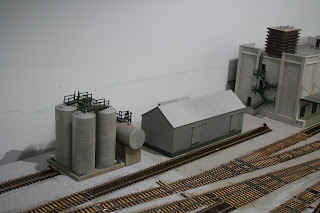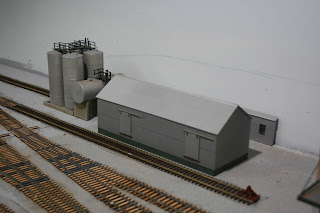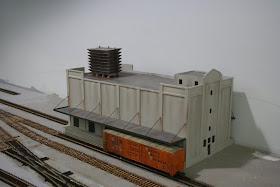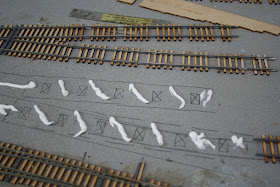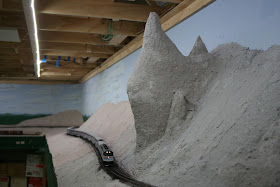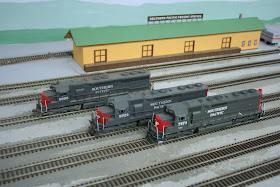With the long-delayed mainline track revision in the throat area of RR-East Eugene completed, I turned to the open space against the wall hemmed in by the new mainline tracks between the Eugene depot area and the fanning-out of the departure end of the Arrival-Departure Yard. I always planned to develop more Eugene industry in this area, but awaited the completion of the mainline track.
A new industrial siding parallels the mainline track through this area. This track is accessed at the depot end via one of the double-slip switches installed as part of the mainline track effort. The other end of the industrial siding connects to the “Halsey Branch” which runs along the wall beside the departure end of the Arrival-Departure Yard. The RR-East turnout along this siding was installed with the access switch that helps form part of the Halsey Branch. The remaining track and turnouts were left to be determined once I had a clear idea of the space.
I left this part of the planning undetermined in my original track plan. “There be industries.” I have learned over time to leave some spaces of a layout undesignated to allow them to artistically “speak” to the designer (me). I needed a sense of the three-dimensional space, aided by a couple of building mock-ups. I settled on adding six industrial spurs off the siding.
New industrial siding with six turnouts for spurs alongside the pair of main tracks joining the Eugene Arrival-Departure Yard to the Eugene Depot area (behind and to the right).
With space for more industry, the task of picking those industries proved both interesting and challenging. I wanted to stay true to Eugene, but the second largest city in Oregon provides a lot of industry variety for selection.
A couple of industries were identified throughout the long design and construction phases for this layout—a couple of decades now. Nabisco had a bakery warehouse closer to the depot, but I could not fit it in there. Still, I wanted Nabisco on this layout. The photo above shows a Walthers “Magic Pan Bakeries” kit box (933-2915) just poking into the right side of the photo. That is where something using those kit pieces will eventually emerge. In the middle of the photo and industrial siding are sides from the Walthers “R.J. Frost Ice and Storage” kit (933-3020) that will become Eugene Freeze. I have always liked this kit structure. It fits well in many areas of the country, including here in Oregon. Ordinarily, I resist using stock Walthers structures. They appear on many, many layouts. I hope I can modify these enough to at least show they are not stock, out of the box.
Another industry that commended itself to me is the partially-assembled Campbell plastics manufacturer—the olive-green structure in the photo. I started building this kit many years ago. Campbell designed this structure as a lift-slab (sides) building with a bow roof. This is very common mid-century industrial architecture on the West Coast, so it fits well here. Little did I realize when I started this kit and picked a color scheme that the green would fit well in Eugene. The University of Oregon (boo-hiss—I am an OSU Beaver!) colors are green and gold, so a lot of structures around Eugene pick up on that. Maybe this is a plant making little rubber duckies! <wink>
With three of the six sidings determined by both Eugene industry research and existing structure kits, the other three need something different. From days gone by, I recalled a “petroleum row” north of the Eugene downtown. Those bulk oil dealers are no longer there, replacing railroad service with pipelines and trucks. Still, bulk oil dealers were a staple of railroading for much of the Twentieth Century. With the bulk oil dealers no longer showing on SP (SPINS) track charts of 1977, I needed to look elsewhere. I conferred with one of my regular crew members living in Eugene, a retired SP engineer. He and his wife confirmed my memories and suggested a couple of dealer names and oil brands. I subsequently found a Eugene City Planning Department historic document that added to my understanding of this now-absent industry. One of the spurs will serve two or three dealers, just as they did back when they were rail served.
Another industry was identified when I consulted my model railroad “brain trust.” I posed a question to several fellow modelers, particularly the few with strongly prototype-based layouts. One came back to me with an excellent suggestion—survey my freight car fleet to identify if any car type had under-represented industry on my railroad. That quickly led to my identification of mill gondolas as that under-used car type. At least one steel fabricator was identified and another is either a fabricator or scrap yard feeding steel scrap to a steel mill near Portland. I will place a steel fabricator on the spur at the RR-East end of the industrial siding, tightly alongside the wall.
The final industry spot floated around in my head for a while. I had a number of possibilities, including another bulk oil dealer spur or perhaps one of the many wood products mills in town. I decided I did not need to add still more oil dealers, letting the single spur with two or three dealers suffice. I disposed of the wood products mills as they consume a lot of space and I already have three large mills represented on my railroad. Looking at the SPINS track charts again, I spotted the Bi-Mart warehouse. Bi-Mart is an Oregon-based retailer much like Costco, but definitely local to Oregon. Home base is Eugene. We frequently shop at Bi-Mart. We have a funny story concerning our daughter’s “discovery” of Bi-Mart during her Freshman year at OSU. Parents can’t tell a teen anything! Bi-Mart has earned its way onto this railroad!
While I was settling the industries, I still needed to fabricate the turnouts and build the industrial spur. I use FastTracks tooling for my turnouts. This time, instead of confining the rails to that needed to fill out a FastTracks switch tie block, I chose to extend the rails on both ends. I have noted with more recent turnout installations that I get better results with a bit more rail extending from the turnout, particularly on the point end. This time, I chose to extend the rails enough that I could join them together and not need any additional track to complete the industrial siding.
I had some FastTracks flex ties from a prior project, but I needed more ties for this project. Instead of the flex ties, I selected both fixed (straight) and flexible “Quick Sticks” tie blocks. These have groups of five ties separated by spaces to insert and use a pc-board tie to maintain rail gauge. This took some assembly planning on my part. I needed to glue the rails to the ties, just like the switch blocks, but then cut out the connecting web to allow insertion of the pc-board ties. I also needed to account for the gentle curve needed between a pair of the turnouts—an area using the flexible “Quick Sticks.”
Underside of track sections extended from the switch tie block using “Quick Sticks” ties. The upper track has had the gap webbing removed and the underside of the rail cleared of paint to allow insertion and soldering of a pc-board tie. The lower track still has the webs in place.
I formed the curved track section in place, gluing it and fixing it with a hot soldering iron (heats and vulcanizes the Pliobond adhesive). I used both three-point track gauges and “RibbonRail” curve fixtures to assist this process. Once that set, I removed the turnout and track and removed the blank space webbing.
Once all the turnouts and extended tracks were mounted on their ties, I needed to mount them on the cork roadbed. This was done with adhesive caulk, as with the rest of my railroad. I marked all the gaps for pc-board ties and made sure the caulk was not present in those areas as I spread it elsewhere to fix the ties to the roadbed. I chose to mount turnouts one, three, and five first, and then follow up with the other two, fitting them to the already installed turnouts.
Initial dabs of caulk adhesive laid before spreading in place and then mounting the turnout and extended tracks.
The track is now installed for this industrial siding, although I do need to install the pc-board ties. I move next to installing switch machines, controls, and track wiring. I also need to install the rest of the spurs, for which I will use regular flex track. I also can begin fabricating the industrial structures for this busy section of railroad.
